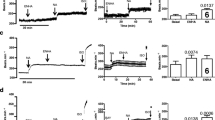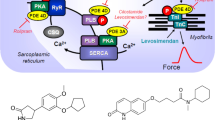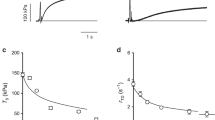Summary
The present study was performed to compare the effects of the new positive inotropic phosphodiesterase III inhibitors pimobendan, adibendan, and saterinone on the isometric force of contraction in electrically driven ventricular trabeculae carneae isolated from explanted failing (end-stage myocardial failure) with those from nonfailing (prospective organ donors) human hearts. In preparations from nonfailing hearts the phosphodiesterase inhibitors, as well as the aβ-adrenoceptor agonist isoprenaline, the cardiac glycoside dihydroouabain, and calcium, which were studied for comparison, revealed pronounced positive inotropic effects. The maximal effects of pimobendan, adibendan, and saterinone amounted to 56%, 36% and 45%, respectively, of the maximal effect of calcium. In contrast, in preparations from failing hearts the phosphodiesterase III inhibitors failed to significantly increase the force of contraction and the effect of isoprenaline was markedly reduced. The effects of dihydroouabain and calcium were almost unaltered. The diminished effects of isoprenaline were restored by the concomitant application of phosphodiesterase inhibitors.
To elucidate the underlying mechanism of the lack of effect of the phosphodiesterase III inhibitors in the failing heart we also investigated the inhibitory effects of these compounds on the activities of the phosphodiesterase isoenzymes I–III separated by DEAE-cellulose chromatography from both kinds of myocardial tissue. Furthermore, the effects of pimobendan and isoprenaline on the content of cyclic adenosine monophosphate (determined by radioimmunoassays) of intact contracting trabeculae were studied. The lack of effect of the phosphodiesterase inhibitors in failing human hearts could not be explained by an altered phosphodiesterase inhibition, since the properties of the phosphodiesterase isoenzymes I–III and also the inhibitory effects of the phosphodiesterase inhibitors on these isoenzymes did not differ between failing and nonfailing human myocardial tissue. Instead, it may be due to a diminished formation of cyclic adenosine monophosphate in failing hearts, presumably caused mainly by a defect in receptor-adenylate cyclase coupling at least in idiopathic dilated cardiomyopathy. Both the basal and the pimobendan-stimulated or isoprenaline-stimulated contents of cyclic adenosine monophosphate of intact contracting trabeculae from failing hearts were decreased compared with the levels in nonfailing hearts. However, under the combined action of isoprenaline and pimobendan the cyclic adenosine monophosphate level reached values as high as with each compound alone in nonfailing preparations, and in addition the positive inotropic effect of isoprenaline was restored.
These findings may have important clinical implications. Along with the elevated levels of circulating catecholamines the positive inotropic effects of the phosphodiesterase inhibitors may be maintained in patients with heart failure. Furthermore, the concomitant application of a β-adrenoceptor agonist and a phosphodiesterase inhibitor might be beneficial in terminal heart failure refractory to conventional therapeutic regimens.
Similar content being viewed by others
References
Armah BI, Hofferber E, Jacobitz P (1988) Positive inotropic and vasodilatory actions of saterinone in vivo. Arzneimittelforschung 38:1303–1309
Bauer AC, Schwabe U (1980) An improved assay of cyclic 3′,5′-nucleotide phosphodiesterases with QAE-sephadex columns. Naunyn-Schmiedeberg's Arch Pharmacol 311:193–198
Baumann G, Felix S, Heinl K-W (1989) Cardiovascular profile of saterinone (BDF 8634) in patients with congestive heart failure (CHF) — a comparison to dobutamine (DOB) and nitroprusside (NPN). 1st International Symposium on Heart Failure — Mechanisms and Management, Jerusalem, 21–25 May 1989
Berger C, Meyer W, Scholz H, Starbatty J (1985) Effects of the benzimidazole derivatives pimobendan and 2-(4-hydroxy-phenyl)-5-(5-methyl-3-oxo-4,5-dihydro-2H-6-pyridazinyl)benzimidazole HCl on phosphodiesterase activity and on force of contraction in guinea-pig hearts. Arzneimittelforsch 35:1668–1673
Bethke T, Brunkhorst D, Leyen H von der, Meyer W, Nigbur R, Scholz H (1988) Mechanism of action and cardiotonic activity of a new phosphodiesterase inhibitor, the benzimidazole derivative adibendan (BM 14.478), in guinea-pig hearts. NaunynSchmiedeberg's Arch Pharmacol 337:576–582
Böhm M, Brückner R, Hackbarth I, Haubitz B, Linhart R, Meyer W, Schmidt B, Schmitz W, Scholz H (1984) Adenosine inhibition of catecholamine-induced increase in force of contraction in guinea-pig atrial and ventricular heart preparations. Evidence against a cyclic AMP- and cyclic GMP-dependent effect. J Pharmacol Exp Ther 230:483–492
Böhm M, Beuckelmann D, Brown L, Feiler G, Lorenz B, Näbauer M, Kemkes B, Erdmann E (1988a) Reduction of beta-adrenoceptor density and evaluation of positive isotropic responses in isolated, diseased human myocardium. Eur Heart J 9:844–852
Böhm M, Diet F, Kemkes B, Erdmann E (1988b) Enhancement of the effectiveness of milrinone to increase force of contraction by stimulation of cardiac beta-adrenoceptors in the failing human heart. Klin Wochenschr 66:957–962
Böhm M, Gierschik P, Jakobs K-H, Pieske B, Schnabel P, Ungerer M, Erdmann E (1990) Increase of Giα in human hearts with dilated but not ischemic cardiomyopathy. Circulation 82: 1249–1265
Bradford MM (1976) A rapid and sensitive method for the quantitation of microgram quantities of protein utilizing the principle of protein-dye binding. Anal Biochem 72:248–254
Bristow MR, Ginsburg R, Minobe W, Cubicciotti RS, Sageman WS, Lurie K, Billingbam ME, Harrison DC, Stinson EB (1982) Decreased catecholamine sensitivity and β-adrenergic-receptor density in failing human hearts. N Engl J Med 307:205–211
Bristow MR, Ginsburg R, Strosberg A, Montgomery W, Minobe W (1984) Pharmacology and isotropic potential of forskolin in the human heart. J Clin Invest 74:212–223
Bristow MR, Ginsburg R, Umans V, Fowler M, Minobe W, Rasmussen R, Zera P, Menlove R, Shah P, Jamieson S, Stinson EB (1986) β1- and β2-adrenergic-receptor subpopulations in nonfailing and failing human ventricular myocardium: coupling of both receptor subtypes to muscle contraction and selective β1-receptor down-regulation in heart failure. Circ Res 59:297–309
Bristow MR, Port JD, Sandoval AB, Rasmussen R, Ginsburg R, Feldman AM (1989) β-Adrenergic receptor pathways in the failing human heart. Heart Failure 5:77–90
Brunkhorst D, Leyen H von der, Meyer W, Schmidt-Schumacher C, Scholz H (1988) Selective inhibition of cAMP phosphodiesterase III activity by the cardiotonic agent saterinone in guinea pig myocardium. Arzneimittelforschung 38:1293–1298
Brunkhorst D, Leyen H von der, Meyer W, Nigbur R, Schmidt-Schumacher C, Scholz H (1989) Relation of positive inotropic and chronotropic effects of pimobendan, UD-CG 212 Cl, milrinone and other phosphodiesterase inhibitors to phosphodiesterase III inhibition in guinea-pig heart. NaunynSchmiedeberg's Arch Pharmacol 339:575–583
Colucci WS (1989) Observations on the intracoronary administration of milrinone and dobutamine to patients with congestive heart failure. Am J Cardiol 63:17A–22A
Colucci WS, Wright RF, Braunwald E (1986) New positive inotropic agents in the treatment of congestive heart failure. Mechanisms of action and recent clinical developments. N Engl J Med 314:290–299; 349–358 Daly JW (1984) Forskolin, adenylate cyclase, and cell physiology: an overview. Adv Cyclic Nucleotide Prot Phosphoryl Res 17:81–89
Danielsen W, Leyen H von der, Meyer W, Neumann J, Schmitz W, Scholz H, Starbatty J, Stein B, Döring V, Kalmár P (1989) Basal and isoprenaline-stimulated CAMP content in failing versus nonfailing human cardiac preparations. J Cardiovasc Pharmacol 14:171–173
Erdmann E (1988) The effectiveness of inotropic agents in isolated cardiac preparations from the human heart. Klin Wochenschr 66:1–6
Feldman MD, Copelas L, Gwathmey JK, Phillips P, Warren SE, Schoen FJ, Grossmann W, Morgan JP (1987) Deficient production of cyclic AMP: pharmacologic evidence of an important cause of contractile dysfunction in patients with end-stage heart failure. Circulation 75:331–339
Feldman AM, Cates AE, Veazey WB, Hershberger RE, Bristow MR, Baughman KL, Baumgartner WA, Dop C van (1988) Increase of the 40,000-mol wt pertussis toxin substrate (G protein) in the failing human heart. J Clin Invest 82:189–197
Gage J, Rutman H, Lucido D, LeJemtel TH (1986) Additive effects of dobutamine and mmrinone on myocardial contractility and ventricular performance in patients with severe heart failure. Circulation 74:367–373
Gilbert EM, Mealey P, Volkman K, Eastburn T, O'Connell JB, Renlund DG, Bristow MR (1988) Combination therapy with enoximone and dobutamine is superior to nitroprusside and dobutamine in heart failure. Circulation 78 [Supl 11]: II-28
Gilbert EW, Port JD, Hershberger RE, Bristow MR (1989) Clinical significance of alterations in the β-adrenergic receptor-adenylate cyclase complex in heart failure. Heart Failure 5:91–98
Ginsburg R, Bristow MR, Billingham ME, Stinson EB, Schroeder JS, Harrison DC (1983) Study of the normal and failing isolated human heart: decreased response of failing heart to isoproterenol. Am Heart J 106:535–540
Goldstein RE, Skelton CL, Levey GS, Glancy DL, Beiser GD, Epstein SE (1971) Effects of chronic heart failure on the capacity of glucagon to enhance contractility and adenyl cyclase activity of human papillary muscles. Circulation 44:638–648
Hauf GF, Grom E, Jähnchen E, Roskamm H (1989) Acute and long-term hemodynamic effects of pimobendan (UD-CG 115 BS) in comparison with captopril. J Cardiovasc Pharmacol 14 [Suppl 2]:S49-S56
Honerjäger P, Heiss A, Schäfer-Korting M, Schönsteiner G, Reiter M (1984) UD-CG 115 BS — a cardiotonic pyridazinone which elevates cyclic AMP and prolongs the action potential in guinea-pig papillary muscle. Naunyn-Schmiedeberg's Arch Pharmacol 325:259–269
Ikezono K, Michel MC, Zerkowski H-R, Beckeringh JJ, Brodde OE (1987) The role of cyclic AMP in the positive inotropic effect mediated by β1- and β2-adrenoceptors in isolated human right atrium. Naunyn-Schmiedeberg's Arch Pharmacol 335:561–566
Ito M, Tanaka T, Saitoh M, Masuoka H, Nakano T, Hidaka H (1988) Selective inhibition of cyclic AMP phosphodiesterase from various human tissues by milrinone, a potent cardiac bipyridine. Biochem Pharmacol 37:2041–2044
Katz SD, Forman R, Giustino SR, Sonnenblick EH, LeJemtel TH (1987) Double-blind, randomized evaluation of pimobendan, a new inotrope and vasodilator agent for refractory heart failure. Circulation 76 [suppl IV]:IV-178
Lee DC-S, Johnson RA, Bingham JB, Leahy M, Dinsmore RE, Goroll AH, Newell JB, Strauss HW, Haber E (1982) Heart failure in outpatients. A randomized trial of digoxin versus placebo. N Engl J Med 306:699–705
Levine TB, Francis GS, Goldsmith SR, Simon AB, Cohn JN (1982) Activity of the sympathetic nervous system and renin-angiotensin system assessed by plasma hormone levels and their relation to hemodynamic abnormalities in congestive heart failure. Am J Cardiol 49:1659–1666
Meel van JCA (1985) Cardiovascular effects of the positive inotropic agents pimobendan and sulmazole in vivo. Arzneimittelforsch 35:284–288
MorganJP, Chesebro JH, Gersh BJ, Harrison CE (1983) The use of theophylline as an adjunct in the treatment of myocardial failure. Clin Res 31:207A
Müller-Beckmann B, Sponer G, Strein K, Bartsch W (1988) Hemodynamic profile of BM 14.478: a new positive inotropic and vasodilating agent. J Cardiovasc Pharmacol 11:1–7
Neumann J, Schmitz W, Scholz H, Meyerinck L von, Döring V, Kalmár P (1988) Increase in myocardial Gi-proteins in heart failure. Lancet 11:936–937
Packer M (1988 a) Neurohormonal interactions and adaptations in congestive heart failure. Circulation 77:721–730
Packer M (1988 b) Vasodilator and inotropic drugs for the treatment of chronic heart failure: distinguishing hype from hope. J Am Coll Cardiol 12:1299–1317
Rauch R, Zimmermann R, Molitor St, Smolarz A, Osterziel KJ, Tillmanns H (1988) Hemodynamic effects of BM 14.478 assessed in patients with chronic heart failure. Eur Heart J 9 [Suppl 1]: 178
Reeves ML, Leigh BK, England PJ (1987) The identification of a new cyclic nucleotide phosphodiesterase activity in human and guinea-pig cardiac ventricle. Biochem J 241: 535–541
Renard M, Walter M, Liebens I, Dresse A, Bernard R (1988) Pimobendane (UD-CG 115 BS) in chronic heart failure. Short-term and one-months effects of a new inotropic vasodilating agent. Chest 93:1159 -1164
Robertson DW, Hayes JC (1988) Positive inotropic agents in management of congestive heart failure. ISI Atlas Sci [Pharmacol] 2:129–135
Saborowski F, Peters P, May E, Schneider M (1988) Haemodynamic data after administration of BM 14 478, a new positive inotropic agent. Eur Heart J 9 [Suppl 1]:176
Schmitz W, Scholz H, Erdmann E (1987) Effects of α- and β-adrenergic agonists, phosphodiesterase inhibitors and adenosine on isolated human heart muscle preparations. Trends Pharmacol Sci 8:447–450
Scholz H (1984) Inotropic drugs and their mechanisms of action. J Am Coll Cardiol 4:389–397
Thomas JA, Marks BH (1978) Plasma norepinephrine in congestive heart failure. Am J Cardiol 41:233–243
Thompson WJ, Appleman MM (1971) Multiple cyclic nucleotide phosphodiesterase activities from rat brain. Biochemistry 10:311–316
Thompson WJ, Terasaki WL, Epstein PM, Strada SJ (1979) Assay of cyclic nucleotide phosphodiesterase and resolution of multiple molecular forms of the enzyme. Adv Cyclic Nucleotide Res 10:69–92
Weishaar RE, Burrows SWD, Kobylarz DC, Quade MM, Evans DB (1986) Multiple molecular forms of cyclic nucleotide phosphodiesterase in cardiac and smooth muscle and in platelets. Biochem Pharmacol 35:787–800
Weishaar RE, Kobylarz-Singer DC, Steffen RP, Kaplan HR (1987) Subclasses of cyclic AMP-specific phosphodiesterase in left ventricular muscle and their involvement in regulating myocardial contractility. Circ Res 61: 539–547
Wilmshurst PT, Walker JM, Fry CH, Mounsey JP, Twort CHC, Williams BT, Davies MJ, Webb-Peploe MM (1984) Inotropic and vasodilator effects of amrinone on isolated human tissue. Cardiovasc Res 18:302–309
Author information
Authors and Affiliations
Additional information
Some of the results reported in this paper have already been presented in abstract form at the 61 st Session of the American Heart Association, Washington, DC, Nov. 1988 (von der Leyen et al., Circulation 78 (Suppl II): 11-360, 1988), at the Fall Meeting of the German Society of Pharmacology and Toxicology, Sept. 1988 (Schmitz et al., Naunyn-Schmiedeberg's Arch Pharmacol 338 (Suppl): R 16, 1988), at the 30th Spring Meeting of the German Society of Pharmacology and Toxicology, March 1989 (Meyer et al., Naunyn-Schmiedeberg's Arch Pharmacol 339 (Suppl): R 53, 1989), and at the XIII Congress of the International Society For Heart Research, Ann Arbor, MI, May 1989 (Meyer et al., J Mol Cell Cardiol 21 (Suppl 11): S. 50, 1989) mis|Send offprint requests to Wilfried Meyer at the above address
Rights and permissions
About this article
Cite this article
von der Leyen, H., Mende, U., Meyer, W. et al. Mechanism underlying the reduced positive inotropic effects of the phosphodiesterase III inhibitors pimobendan, adibendan and saterinone in failing as compared to nonfailing human cardiac muscle preparations. Naunyn-Schmiedeberg's Arch Pharmacol 344, 90–100 (1991). https://doi.org/10.1007/BF00167387
Received:
Accepted:
Issue Date:
DOI: https://doi.org/10.1007/BF00167387




